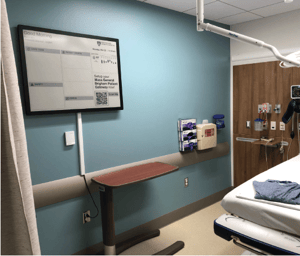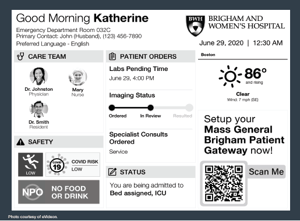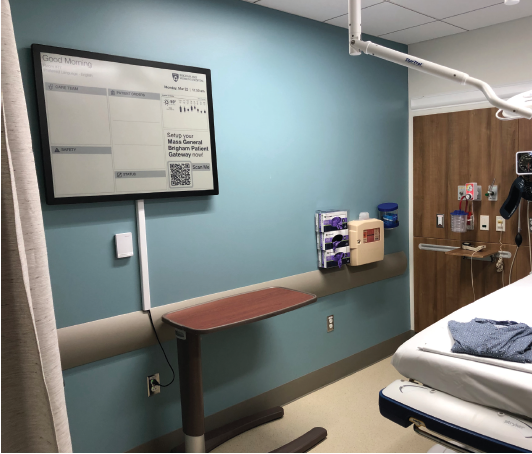Whether we have visited the Emergency Department (ED) or have seen a set on TV or the movies – we know there are standard pieces – gurney, IV stands, monitors, oxygen equipment and more. What we don’t always notice is how the patient’s care is monitored – charting, in healthcare-speak. There is someone dedicated to taking down all the information – vital signs, medications, treatments, names of caregivers – all the minutia.
 ED room at Brigham and Women's Hospital, Boston. Image credit: E Ink Corporation
ED room at Brigham and Women's Hospital, Boston. Image credit: E Ink Corporation
All of the critical information needs to be captured and updated in real time. While it is referred to as charting, it is really a digital file. The designated charter will use a keyboard or a tablet to input the information. The hospital's Electronic Medical Record systems (EMR) holds the information for instant access to staff.
Here’s the picture – a critically ill patient is attended to in the ED. The pace is fast. Information is flying back and forth. How can all the providers in the room stay up to date on the latest information?
 eVideon Digital Whiteboard. Image credit: E Ink Corporation
eVideon Digital Whiteboard. Image credit: E Ink Corporation
Hospitals have long used whiteboards and erasable markers to communicate patient information and status. The whiteboard hangs in the room with one or more color markers. Staff periodically updates the whiteboard manually. Within seconds of updating, the information may be outdated.
Why even bother with a whiteboard? Patient security and satisfaction is the short answer. Surveys have proven that a whiteboard helps a patient feel secure and assists the patient in understanding their care.
In a patient room, this has worked well enough. Some manual whiteboards have been merged with an LCD screen – similar to a TV. Sounds like a great solution – but it’s not.
LCD screens emit blue light – which is not only disruptive to sleep but can negatively affect a patient and impede healing. Our partners have developed an E Ink Digital Paper whiteboard that emits no light, is lightweight and easy to install. Digital whiteboards built with E Ink Digital Paper consume much less power than LCD screens in just the same way as eReaders, eNotes and other E Ink Digital Paper products do – they only draw power when the image is updated.
Brigham and Women’s Hospital in Boston, Massachusetts, combined with a consortium of companies, tested the impact of a new player in the ED – Digital whiteboard produced by Avalue with E Ink Digital Paper.
Spoiler alert – the results are definitely positive:
98% said they had no trouble resting with the digital whiteboard in their room.
92% said the digital whiteboard was not distracting
70% said the digital whiteboard was either quite a bit or extremely helpful in
helping them understand what was happening during their stay
Patients with the digital whiteboard were more likely to feel they were informed about
delays in their care, and more knowledgeable about what to do in the immediate
post-discharge setting.
Read the entire whitepaper for more information. Visit the Library page at E Ink for more blog posts, whitepapers, recorded webinars and more.
What’s in your hospital room?


Leave Comment